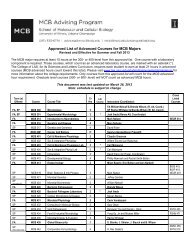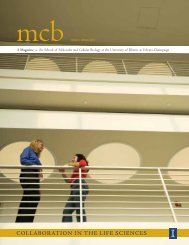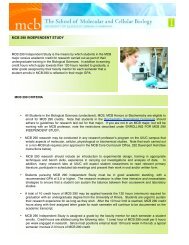breast cancer research • mcb as pre-med - The School of Molecular ...
breast cancer research • mcb as pre-med - The School of Molecular ...
breast cancer research • mcb as pre-med - The School of Molecular ...
Create successful ePaper yourself
Turn your PDF publications into a flip-book with our unique Google optimized e-Paper software.
Herbert L. Carter Fellowship recipient Abhinav Luthra (Abhi), a 2nd year Ph.D.<br />
student in Biochemistry and member <strong>of</strong> the Sligar lab, uses a high performance<br />
liquid chromatography column to isolate individual proteins from a group. “<strong>The</strong><br />
better you understand the properties <strong>of</strong> an enzyme that make it unique, the<br />
better you can manipulate its function specifically,” says Abhi about the diagnostic<br />
tools used to study one <strong>of</strong> the enzymes involved in estrogen reception.<br />
6 . <strong>mcb</strong><br />
stePhen slIgar<br />
Director <strong>of</strong> MCB and I.C. Gunsalus Pr<strong>of</strong>essor <strong>of</strong> Biochemistry Stephen<br />
Sligar’s lab is taking another approach. He is looking at ways to block<br />
the production <strong>of</strong> estrogen in the <strong>bre<strong>as</strong>t</strong> earlier in the chemical pathway<br />
by targeting aromat<strong>as</strong>e, the enzyme that makes estrogen from testosterone<br />
and androstenedione.<br />
Aromat<strong>as</strong>e is a key pharmaceutical drug target for estrogen responsive<br />
<strong>bre<strong>as</strong>t</strong> <strong>cancer</strong>s. By understanding the mechanistic details <strong>of</strong> this important<br />
enzyme, Sligar’s lab hopes to develop a therapeutic that blocks<br />
aromat<strong>as</strong>e’s estrogen-making activity in <strong>cancer</strong> cells without causing a<br />
systemic loss <strong>of</strong> estrogen. This would provide an improvement, in terms<br />
<strong>of</strong> efficacy and specificity, over current aromat<strong>as</strong>e inhibitors in the market<br />
— letrozole, an<strong>as</strong>trozole and exemestane — thereby minimizing the<br />
side effects <strong>as</strong>sociated with the current generation <strong>of</strong> therapies.<br />
However, “studying this enzyme is very difficult because once you<br />
isolate it from the membrane, it’s usually dead,” says Sligar. In a major<br />
step forward, Sligar’s lab created an environment that keeps the enzyme<br />
functioning. This so-called Nanodisc technology is a nanoscale membrane<br />
environment that helps maintain full functionality <strong>of</strong> the protein.<br />
“If you understand how the enzyme works, and there are mechanistic<br />
details distinct from similar enzymes, you can design a better, more targeted,<br />
drug,” says Sligar. With graduate student Abhinav Luthra, Sligar<br />
h<strong>as</strong> discovered that this appears to indeed be the c<strong>as</strong>e with aromat<strong>as</strong>e.<br />
<strong>The</strong> Sligar lab is now using this knowledge to design the next generation<br />
<strong>of</strong> pharmaceuticals.
















